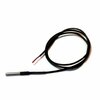Peter Flood
Member
I'm keen to build an automated water temperature sensor, it would have a sim card and use 4g to send the temperature, every 30 mins via http, to a backend I'd build. It would be battery powered, some rough calculations make me think the battery would last several months although solar charging is an option too.
The sensor I have in mind is a DS18B20 with a long cable (up to 15m in length), they're epoxied into a protective casing (waterproof, see pictures). I've used these before for controlling fermentation temperature when brewing beer (via a thermowell, didn't touch the beer), they're not perfectly accurate, I tested 3-5 and recall the readings being in a 1.5˚C range however that's not a problem as it's the trend I'm interested in (eg when is the temperature rising).
The main concern I have, and the reason for this post, is that I'm not sure how best to fix the sensor in place under the water. The river I have in mind is pretty small, when flooded the level is about 2m higher, a level of 2.5m higher would be a 10-20 year event I guess. My current best idea is when the level is low, getting in at a deep pool and screwing it to a tree on the downstream side to protect it from debris floating down. The sensors are cheap so replaceable, but obvioudly awkward to replace, hopefully the cable would survive the harsh environment. The hardware the sensor is connected to costs around £40, it would be above the waterline but would have to be able to resist the elements, guessing I'd put it into some kind of waterproof box half way up the tree. The sim card with data plan would cost about £30/year.
Would be great to hear ideas about how to fix it in place or any other improvements, particularly to make it more robust.
The sensor I have in mind is a DS18B20 with a long cable (up to 15m in length), they're epoxied into a protective casing (waterproof, see pictures). I've used these before for controlling fermentation temperature when brewing beer (via a thermowell, didn't touch the beer), they're not perfectly accurate, I tested 3-5 and recall the readings being in a 1.5˚C range however that's not a problem as it's the trend I'm interested in (eg when is the temperature rising).
The main concern I have, and the reason for this post, is that I'm not sure how best to fix the sensor in place under the water. The river I have in mind is pretty small, when flooded the level is about 2m higher, a level of 2.5m higher would be a 10-20 year event I guess. My current best idea is when the level is low, getting in at a deep pool and screwing it to a tree on the downstream side to protect it from debris floating down. The sensors are cheap so replaceable, but obvioudly awkward to replace, hopefully the cable would survive the harsh environment. The hardware the sensor is connected to costs around £40, it would be above the waterline but would have to be able to resist the elements, guessing I'd put it into some kind of waterproof box half way up the tree. The sim card with data plan would cost about £30/year.
Would be great to hear ideas about how to fix it in place or any other improvements, particularly to make it more robust.


